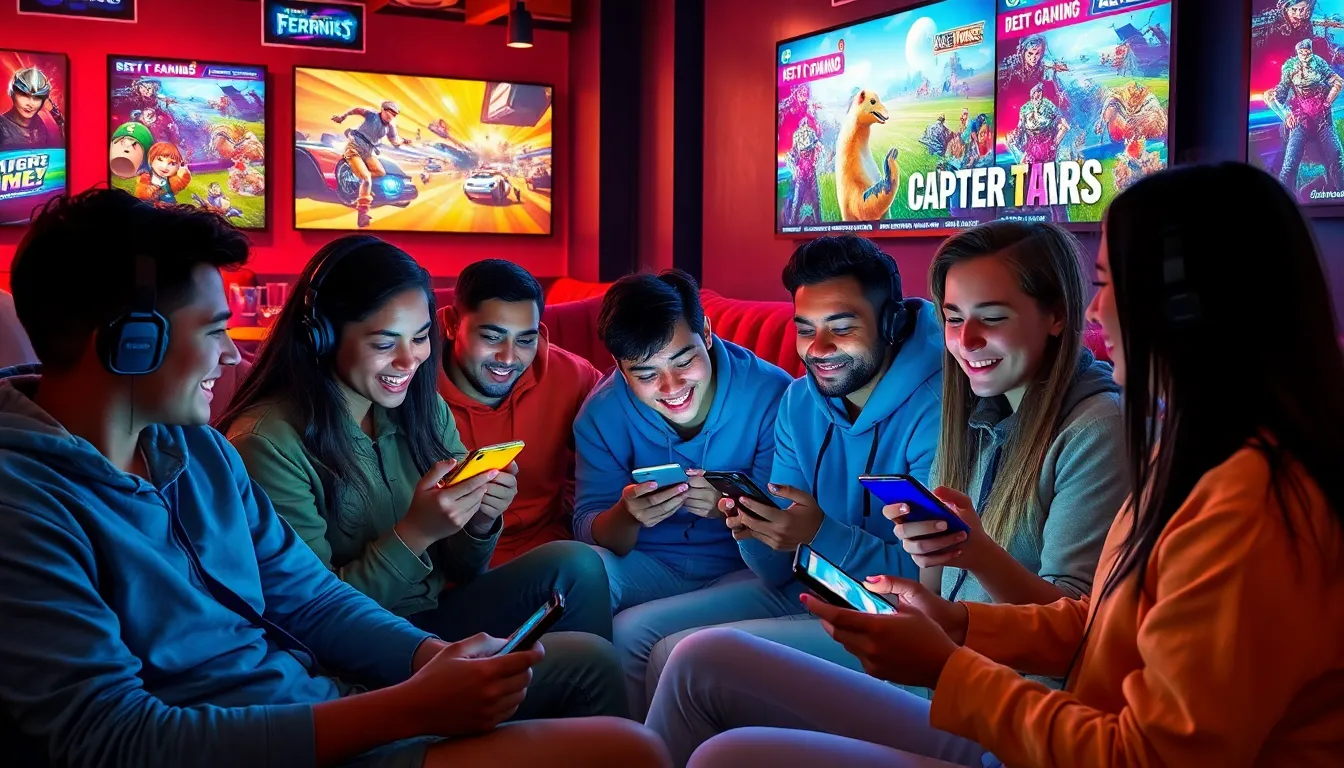In a world where everyone’s glued to their screens, mobile gaming has become the ultimate playground for advertisers. Picture this: gamers tapping away on their devices, blissfully unaware that they’re being served ads that are as entertaining as the games themselves. Mobile gaming advertising isn’t just a trend; it’s a booming industry that’s reshaping how brands connect with consumers.
Overview Of Mobile Gaming Advertising
Mobile gaming advertising has emerged as a crucial strategy for brands aiming to reach diverse audiences. According to Statista, mobile gaming generates over $100 billion in revenue annually, underscoring its significance in the advertising landscape. It offers unique opportunities that traditional advertising channels may not provide. Engaging content captivates gamers, encouraging them to interact with ads during gameplay.
Innovative ad formats enhance user experience, blending seamlessly into games. Interactive ads are particularly effective, as they invite players to participate actively rather than passively viewing content. This level of engagement can lead to increased brand recall and user interest. Advertisers often leverage in-game advertising, banner placements, and rewarded video ads to maximize visibility.
Data shows that mobile gamers are receptive to advertising, with 60% of players noting that they enjoy ads when they offer game-related rewards. Utilizing this insight, brands focus on delivering value through promotions and discounts that resonate with the gaming community.
Targeting and personalization play central roles in mobile gaming advertising success. Advertisers analyze user behavior and preferences to craft tailored messages that align with individual interests. As a result, campaigns yield higher conversion rates than more generalized advertising efforts.
Investments in mobile gaming advertising continue to grow, reflecting its effectiveness. The Interactive Advertising Bureau (IAB) reported a 20% increase in spending on mobile in-game ads in 2022, showcasing the industry’s momentum. This trend signals that mobile gaming remains a vital channel for marketers aiming to engage consumers where they are most attentive.
Mobile Gaming Advertising

Mobile gaming advertising comprises various formats that tap into gamers’ interests and behaviors. Advertisers effectively engage audiences by utilizing innovative approaches that enhance the gaming experience.
In-Game Ads
In-game ads integrate seamlessly within gameplay, providing visibility without interrupting user experience. Various formats, such as banners, billboards, and video ads, capture player attention while they immerse themselves in gaming. These ads can be static or dynamic, allowing brands to showcase multiple products or promotions. Statistics indicate that over 70% of mobile gamers engage with in-game ads when they offer meaningful rewards. This engagement leads to higher brand recall and conversion rates. Brands benefit from strategic placement within popular games, ensuring their messages reach targeted demographics effectively.
Social Media Ads
Social media ads broaden the reach of mobile gaming campaigns by connecting with users on platforms they frequently visit. Advertisers leverage platforms like Facebook, Instagram, and TikTok to promote games and products with tailored content. Engaging visuals and video formats resonate well, capturing the attention of potential customers. Influencer partnerships amplify messages, providing authenticity and fostering trust. Recent data shows that campaigns incorporating social media ads saw a 30% increase in user engagement compared to traditional methods. The synergy between social media and mobile gaming advertising creates a powerful tool for brands to engage their audience directly where they are most active.
Effectiveness Of Mobile Gaming Advertising
Mobile gaming advertising has proven effective in reaching audiences and driving engagement. It connects brands with players in a unique and entertaining way.
Reach And Engagement
Campaigns within mobile gaming reach diverse demographics, including younger audiences who actively participate in gaming culture. Players engage extensively with ads, with over 70% showing interest when rewards are offered. This high engagement rate stems from the immersive nature of gaming, making users more receptive to brand messages. Advertisers leverage this connection to deliver tailored content that resonates with specific interests. As mobile gaming continues to evolve, the potential for targeted outreach enhances brand visibility and consumer interaction.
Return On Investment
Investments in mobile gaming advertising yield significant returns for brands. Data indicates that spending on mobile in-game ads grew by 20% in 2022, reflecting its increasing importance. Brands experience improved ROI when utilizing engaging ad formats like interactive ads, which encourage user participation. Additionally, campaigns that incorporate rewards often lead to higher conversion rates, enhancing overall effectiveness. Advertisers focusing on this medium benefit from targeted user insights, maximizing impact and profitability. The agility of mobile gaming advertising positions it as a crucial channel for driving sustainable growth.
Challenges In Mobile Gaming Advertising
Mobile gaming advertising faces several significant challenges that affect its effectiveness and sustainability. Two prominent issues include ad fatigue and privacy concerns.
Ad Fatigue
Ad fatigue emerges when players encounter repetitive ads during gameplay. Over time, this leads to decreased engagement and diminished effectiveness. Statistics show that almost 35% of mobile gamers experience negative reactions after seeing the same ad multiple times. Unique content becomes essential for maintaining player interest. Brands must innovate consistently to avoid monotony. Implementing variety in ad formats and creative concepts helps keep the player’s experience fresh. Targeting strategies that rotate ads based on user preferences also enhance the likelihood of engagement. New approaches can rejuvenate interest, ensuring ads remain compelling and relevant.
Privacy Concerns
Privacy concerns significantly impact mobile gaming advertising, as regulations tighten and consumers become more aware of data collection practices. Many users express discomfort with invasive tracking methods. According to recent surveys, approximately 70% of players prioritize their privacy over personalized ad experiences. Complying with regulations like GDPR and CCPA demands that advertisers develop transparent data collection strategies. Brands must balance personalization with respect for user privacy. Building trust through clear communication regarding data usage strategies can foster more positive user interactions. Ensuring compliance while delivering customized experiences presents both a challenge and an opportunity in mobile gaming advertising.
Future Trends In Mobile Gaming Advertising
Emerging trends indicate a shift towards innovative advertising strategies within mobile gaming. Major developments include augmented reality and personalized advertising.
Augmented Reality Integration
Augmented reality (AR) is becoming a game-changer for mobile gaming advertising. Brands leverage AR technology to create immersive experiences that engage players on a deeper level. Engaging ads that incorporate AR can captivate attention and enhance gameplay by integrating brand elements seamlessly. Research shows that AR ads generate higher levels of user interaction, leading to increased brand recall. Players enjoy interactive activities, which encourage sharing and discussion within social circles. Expect brands to invest more in AR tools, as this format aligns with the preferences of younger audiences.
Personalized Advertising
Personalized advertising is vital for optimizing engagement in mobile gaming. Advertisers analyze user preferences and playing habits, allowing for customized ad experiences. Tailoring content significantly increases the likelihood of interaction, as players respond positively to relevant promotions. Statistics reveal that 80% of users prefer ads aligned with their interests, highlighting the importance of personalization. Dynamic ad formats that adapt to player behavior further enhance effectiveness and build connections. Players appreciate brands that respect their preferences, fostering trust and driving conversion rates. As technology advances, expect personalized ads to dominate mobile gaming strategies.
Conclusion
Mobile gaming advertising is proving to be a transformative force in the marketing landscape. With its ability to engage diverse audiences through innovative and interactive ad formats, brands are finding new ways to connect with consumers. The rise of personalized advertising and the integration of technologies like augmented reality are setting the stage for even greater engagement and effectiveness.
As advertisers navigate challenges like ad fatigue and privacy concerns, the focus on delivering meaningful content will be crucial. The ongoing investment in this sector reflects its importance in reaching gamers where they are most engaged. The future of mobile gaming advertising looks promising, with opportunities for brands to foster deeper connections and drive sustainable growth.

